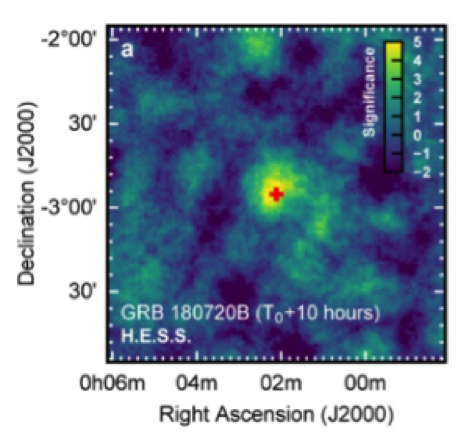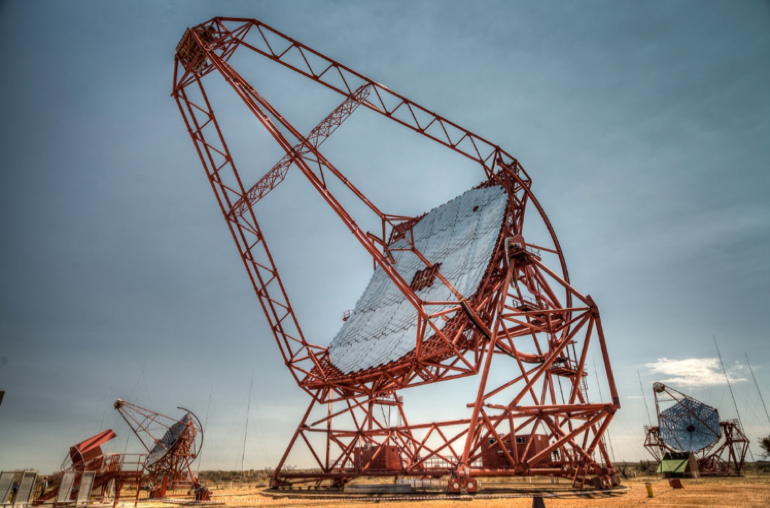
The H.E.S.S. collaboration publishes the first detection of VHE gamma-ray emission from a gamma-ray burst. The
discovery ‘A very-high-energy component deep in the γ-ray burst afterglow’ will appear in the scientific journal
Nature on November 20, 2019. The DOI number for your paper will be 10.1038/s41586-019-1743-9. The publication will be announced on November 20, 19:00 Central European Time and is under embargo until that time. Thereafter, the publication is available online at at the following URL:
http://https: // www.nature.com/articles/s41586-019-1743-9
First detection of gamma-ray burst afterglow in very-high-energy gamma light.
After a decade-long search, scientists have for the first time detected a gamma-ray burst in veryhigh-
energy gamma light. This discovery was made in July 2018 by the H.E.S.S. collaboration
using the huge 28-m telescope of the H.E.S.S. array in Namibia. Surprisingly, this Gamma-ray
burst, an extremely energetic flash following a cosmological cataclysm, was found to emit veryhigh-
energy gamma-rays long after the initial explosion.
Extremely energetic cosmic explosions generate gamma-ray bursts (GRB), typically lasting for only a
few tens of seconds. They are the most luminous explosions in the universe. The burst is followed by a
longer lasting afterglow mostly in the optical and X-ray spectral regions whose intensity decreases
rapidly. The prompt high energy gamma-ray emission is mostly composed of photons several hundredthousands
to millions of times more energetic than visible light, that can only be observed by satellitebased
instruments. Whilst these space-borne observatories have detected a few photons with even
higher energies, the question if very-high-energy (VHE) gamma radiation (at least 100 billion times
more energetic than visible light and only detectable with ground-based telescopes) is emitted, has
remained unanswered until now.
On 20 July 2018, the Fermi Gamma-Ray Burst Monitor and a few seconds later the Swift Burst Alert
Telescope notified the world of a gamma-ray burst, GRB 180720B. Immediately after the alert, several
observatories turned to look at this position in the sky. For H.E.S.S. (High Energy Stereoscopic
System), this location became visible only 10 hours later. Nevertheless, the H.E.S.S. team decided to
search for a very-high-energy afterglow of the burst. After having looked for a very-high-energy
signature of these events for more than a decade, the efforts by the collaboration now bore fruit.
A signature has now been detected with the large H.E.S.S. telescope that is especially suited for such
observations. The data collected during two hours from 10 to 12 hours after the gamma-ray burst
showed a new point-like gamma-ray source at the position of the burst. While the detection of GRBs at
these very-high-energies had long been anticipated, the discovery many hours after the initial event,
deep in the afterglow phase, came as a real surprise. The discovery of the first GRB to be detected at
such very-high-photon energies is reported in a publication by the H.E.S.S. collaboration et al., in the
journal 'Nature' on Nov. 20, 2019.
GRB 180720B was very strong and lasted for about 50 seconds – a relatively long duration indicating
the death of a massive star. In this process, its core collapses to a rapidly rotating black hole. The
surrounding gas forms an accretion disk around the black hole, with gas jets ejected perpendicularly to
the disk plane creating the gamma-ray flashes. Elementary particles are accelerated in these jets to
velocities nearly as high as the speed of light and interact with the surrounding matter and radiation,
leading to the copious production of gamma rays.
The very-high-energy gamma radiation which has now been detected not only demonstrates the
presence of extremely accelerated particles in GRBs, but also shows that these particles still exist or are
created a long time after the explosion. Most probably, the shock wave of the explosion acts here as the
cosmic accelerator. Before this H.E.S.S. observation, it had been assumed that such bursts likely are
observable only within the first seconds and minutes at these extreme energies, and not many hours
after the explosion.
At the time of the H.E.S.S. measurements the X-ray afterglow had already decayed very considerably.
Remarkably, the intensities and spectral shapes are similar in the X-ray and gamma-ray regions. There
are several theoretical mechanisms for the generation of very-high-energy gamma light by particles
accelerated to very-high-energies. The H.E.S.S results strongly constrain the emission to two potential
mechanisms. In both cases, however, the observations raise new questions. "Although energetically one
of these mechanisms is preferred, both the shape of the H.E.S.S. spectrum, and the energy range of the
emission at such late times presents a challenge to both emission scenarios." - says H.E.S.S. scientist
Andrew Taylor.
This breakthrough discovery provides new insights into the nature of gamma-ray bursts. As highlighted
by Edna Ruiz Velasco, PhD. student at MPIK in Heidelberg and one of the corresponding authors of the
publication: "This detection has already revolutionised the way we search for GRBs with Cherenkov
Telescopes. Thanks to this GRB and the lessons learnt, our recently improved observational strategy
has already payed off. We can expect a future with a great number of GRBs detections at very-high
energies and with this, a deeper understanding of these phenomena".
The large central H.E.S.S. telescope with 614 m² mirror area that was used for the first detection of a
GRB in VHE gamma-ray light and two of the four smaller telescopes, each with 107 m² mirror area.
(Credit: MPIK / Christian Föhr, email: christian.foehr![]() mpi-hd.mpg.de)
mpi-hd.mpg.de)
Gamma-Ray bursts are the most luminous explosions in the universe. Within a few seconds they radiate
more energy than the sun in billions of years. Understanding the physical processes at work in these
monstrous explosions are an important goal of modern astrophysics. Artist’s view of a GRB and the
formation of extremely fast jets (Credit: ESO/A. Roquette)
GRB 180720B in very-high-energy gamma light, 10 to 12 hours after the burst as seen by the large
H.E.S.S. telescope. The red cross indicates the position of GRB 180720B, determined from the optical
emission of the GRB. (Credit: H.E.S.S. collaboration, email: contact.hess![]() hess-experiment.eu)
hess-experiment.eu)
Original publication:
A new very-high-energy component deep in the Gamma-ray Burst afterglow, Nature, 2019
Authors: The H.E.S.S. Collaboration et al. *
Websites:
H.E.S.S. home page: http://www.mpi-hd.mpg.de/HESS
H.E.S.S instrument: http://www.mpi-hd.mpg.de/HESS/pages/about/
Contacts:
Prof. Dr. Stefan Wagner (Director, H.E.S.S.)
Phone: +49 6221 541712
E-mail: swagner![]() lsw.uni-heidelberg.de
lsw.uni-heidelberg.de
Prof. Dr. Mathieu de Naurois (Deputy Director, H.E.S.S.)
Phone: +33 1 69 33 55 97
E-mail: denauroi![]() in2p3.fr
in2p3.fr
Edna L. Ruiz Velasco
Phone: +49 6221 516-137
E-mail: edna.ruiz![]() mpi-hd.mpg.de
mpi-hd.mpg.de
Dr. Daniel Parsons
E-mail: daniel.parsons![]() mpi-hd.mpg.de
mpi-hd.mpg.de
Dr. Andrew Taylor
Phone: +49 3376277195
E-mail: andrew.taylor![]() desy.de
desy.de
* The corresponding authors of the original publication are: Edna Ruiz Velasco, Quentin Piel, R. Daniel
Parsons, Elisabetta Bissaldi, Clemens Hoischen, Andrew Taylor, Felix Aharonian, Dmitry Khangulyan
The H.E.S.S. Telescope Array
The results were obtained using the High Energy Stereoscopic System (H.E.S.S.) telescopes in
Namibia. This system of four 13 m diameter telescopes surrounding the huge 28 m H.E.S.S. II
telescope is the world's most sensitive very high-energy gamma ray detector. The H.E.S.S. telescopes
image the faint, short flashes of bluish light emitted when energetic gamma rays interact with the
Earth's atmosphere (so-called Cherenkov light), collecting the light with big mirrors and focusing it
onto extremely fast reacting sensitive cameras. These Cherenkov images allow H.E.S.S. to reconstruct
the properties of the interacting gamma-rays and ultimately detect their sources.
The High Energy Stereoscopic System (H.E.S.S.) team consists of over 200 scientists from Germany,
France, the United Kingdom, Namibia, South Africa, Ireland, Armenia, Poland, Australia, Austria, the
Netherlands, Japan and Sweden, supported by their respective funding agencies and institutions.


https://www.mpi-hd.mpg.de/hfm/HESS/
http://llr.in2p3.fr/premiere-detection-de-l-emission-remanente-d-un-sursaut-gamma-a-tres-haute
http://www.cnrs.fr/fr/premieres-detections-de-sursauts-gamma-tres-haute-energie
https://ria.ru/20191120/1561174891.html
https://www.mpg.de/14155451/gamma-ray-bursts-with-a-high-radiant-power
https://www.mpg.de/14154377/energiereiche-gammablitze?c=2191
https://www.nature.com/articles/d41586-019-03503-6
https://www.nature.com/articles/s41586-019-1743-9
https://www.eurekalert.org/pub_releases/2019-11/kift-fdo111919.php
https://gizmodo.com/strongest-gamma-ray-bursts-ever-recorded-are-illuminati-1839961359
https://nplus1.ru/news/2019/11/20/very-high-energy-grb
https://tass.ru/kosmos/7166251
http://m.raumfahrer.net/news/20112019190319.shtml
https://www.elmundo.es/ciencia-y-salud/ciencia/2019/11/20/5dd433d8fc6c8336298b4816.html
http://www.cnrs.fr/en/node/4240
https://idw-online.de/de/news727367
https://phys.org/news/2019-11-cosmic-monster-explosions-ground-based-gamma-ray.html
http://www.raumfahrer.net/news/astronomie/20112019190319.shtml
https://www.natureasia.com/en/research/highlight/13150
https://www.franceinter.fr/emissions/le-7-9/le-7-9-21-novembre-2019
http://www.ca-se-passe-la-haut.fr/2019/11/detection-inedite-de-photons-ultra.html
https://fr.news.yahoo.com/sursaut-gamma-%C3%A9nergie-record-d%C3%A9tect%C3%A9e-131543817.html
http://Namibia - Windhoek Express
Services/Groupes:
- Astrophysique à Haute Energie
